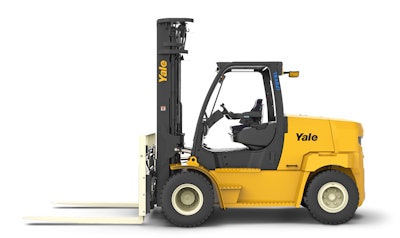
Yale Materials Handling Corporation breaks new ground with factory integrated, high-voltage lithium-ion power in 15,500 to 19,000-pound capacity sit-down counterbalanced lift trucks. The Yale ERP155-170SVNL, ERP175VNL36 and ERP190VNL provide a zero-emission alternative with performance comparable to an internal combustion engine in high-capacity indoor and outdoor applications.
“Environmental considerations are an increasingly important focus for all industries and applications, as are the competitive pressures to streamline lift truck fleets and better manage costs,” says John Santiago, Director, Counterbalance Solutions, Yale Materials Handling Corporation. “Introducing lithium-ion power to equipment for heavy-duty applications can help our customers respond to these challenges, and also provide significant ergonomic benefits for operators.”
The electric powertrain on the ERP-VNL series offers low noise levels and no emissions to help operators remain focused and productive. A standard air ride seat and hydraulic mini-lever controls further prioritize comfort to help operators work at their peak all shift long. To help navigate tight spaces, the Yale ERP155-170SVNL models offer a shortened counterweight design and Turn Assist System.
The lithium-ion battery pairs with efficient, high-power electric motors to deliver performance comparable to an ICE, but uses fewer serviceable components for reduced periodic maintenance requirements. The battery itself is sealed and requires no maintenance.
Lithium-ion batteries also provide consistent power delivery throughout the full battery charge, avoiding the performance degradation found in traditional lead-acid batteries. The battery can also fully charge in less than 90 minutes using the required charger, and opportunity charging capabilities allow operators to plug in whenever convenient to extend runtime and spend less time charging.















![Pros To Know 2026 [color]](https://img.sdcexec.com/mindful/acbm/workspaces/default/uploads/2025/08/prostoknow-2026-color.mduFvhpgMk.png?ar=16%3A9&auto=format%2Ccompress&bg=fff&fill-color=fff&fit=fill&h=135&q=70&w=240)



